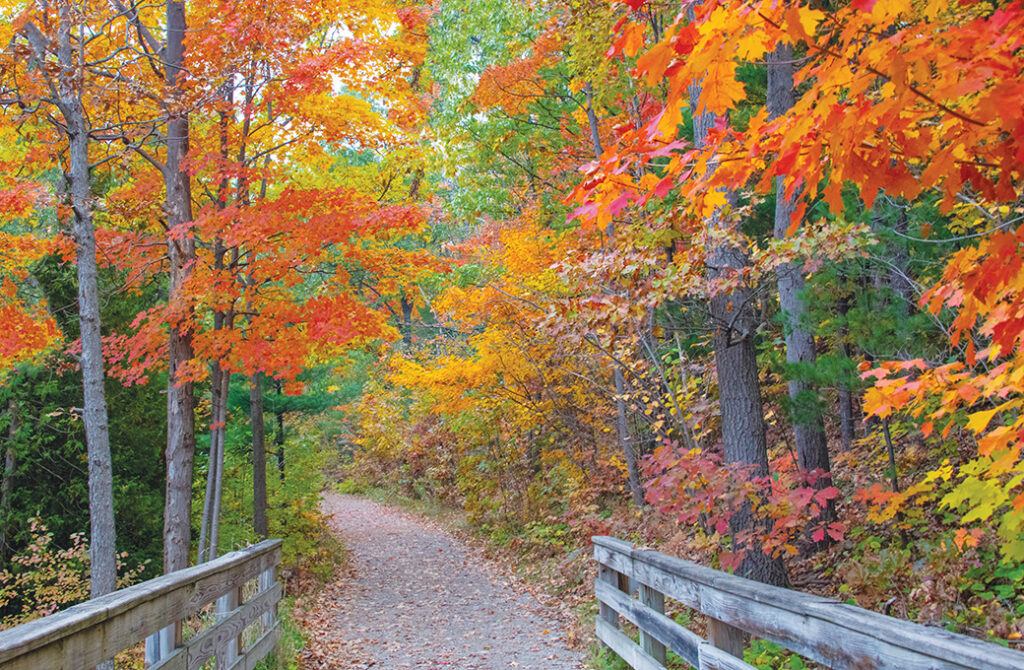A Season of Activity and Stewardship
By Todd Maschke | President, MISORVA
As autumn settles over Michigan, the landscape bursts into vibrant shades of gold, red, and orange. This stunning transformation marks not only a change in the scenery but also the height of outdoor activity for hunters, snowmobilers, ORV riders, hikers, and more. However, with this flurry of activity comes a shared responsibility—one that ensures everyone can enjoy the land safely and sustainably.
Bear and Deer Hunters in the Woods
Autumn in Michigan is synonymous with hunting season. Bear hunters are venturing into the woods, navigating the rugged terrain in pursuit of their quarry. This is more than just a hunt—it’s a tradition deeply rooted in the culture of the region, connecting hunters with the land. Whether they’re scouting or actively hunting, many share the trails and forests with other outdoor enthusiasts.
The approaching deer hunting season sees many preparing for the days ahead, whether by scouting prime areas or simply enjoying the quiet solitude of the woods. The fall foliage provides a picturesque backdrop to these activities, creating a serene yet exhilarating environment for hunters and nature lovers alike.
Snowmobile Clubs Prepare for Winter
While hunters are out in force, snowmobile clubs are busy getting trails ready for the coming snow. These groups are working diligently, brushing and signing trails, and preparing to perform the final drag and leveling before the ground becomes too wet or frozen to grade properly. This preparation is essential to ensure that snowmobile trails remain smooth and safe once winter fully sets in.
ORV Riders Savoring Fall’s Final Days
For ORV riders, fall offers one last chance to enjoy the trails before they become too muddy or covered in snow. The crisp autumn air, combined with the brilliant fall colors, makes for an ideal riding experience. However, once winter arrives, most riders will put their machines away until spring, leaving the trails to snowmobiles, skiers, and other winter sports enthusiasts.
Hiking Through the Backcountry
Hikers are also making the most of the season, exploring the backcountry in search of beautiful fall landscapes. The cooler temperatures and clear skies create perfect hiking conditions, while the changing colors of the forest offer an extraordinary visual experience. Whether it’s a short, leisurely walk or a more challenging trek, the season invites outdoor enthusiasts to enjoy the peaceful beauty of the wilderness.
Non-Motorized Trail Users: One Last Ride Before Winter
For those who prefer non-motorized activities, such as hiking or mountain biking, fall is often the last opportunity to enjoy the trails before the snow sets in. Many of these paths, while ideal for hiking and biking in the fall, will soon be impassable due to mud or snow. As a result, outdoor enthusiasts are taking advantage of the season to savor these trails one last time before winter.
A Shared Experience in the Outdoors
What does all of this mean? It means that, no matter what activity you’re engaged in, we all share the same space. Whether you’re hunting, riding, hiking, horseback riding or working on snowmobile trails, it’s important to remember that the trails and lands we enjoy belong to everyone. You may find yourself crossing paths with others, sharing stories over lunch or exchanging tips about the best routes.
With this shared experience comes a need for mutual respect. It’s vital to be considerate of others, especially when we’re all using the same public lands and shared trails. Slow down when you encounter others, give them space, and always remember that respect for fellow outdoor enthusiasts is essential.
The Importance of Trail Preservation
As the snowmobile season approaches, some trails are being prepared for winter. If you come across a trail that has been prepped for snowmobiling, please tread lightly with your ORV until the snow falls. While it may be tempting to fishtail around a corner, those carefully prepped trails are essential for the safety and enjoyment of all winter sports enthusiasts. We all recall the days when fishtailing around corners was the norm, (how many of us remember putting weight in the back end of a vehicle and yes, even running studded snow tires) but today it’s more important than ever to maintain the integrity of these trails for others.
Protecting ORV Routes and Funding
In recent years, Michigan has seen an increase in damage to its Shared Routes in the fall. Once a trail is designated as an ORV Route, damage repairs must, according to stature, be taken from the ORV funds. This fund is already limited. As the season winds down, it’s crucial for ORV riders to stay engaged with the state advisory group, Off-Road Vehicle Advisory Workgroup of Michigan (ORVAW). Participating in meetings, even virtually via Zoom, provides an opportunity to voice your concerns and ensure that the Department of Natural Resources (DNR) is prioritizing the needs of riders. This is your chance to ensure that ORV routes are not only maintained but that the DNR is making the right decisions about funding and trail management. Just because you may not be riding the program is not frozen until spring! www.michigan.gov/dnr/about/boards/mtac/orv
A Final Thought
As we approach the end of the fall season and prepare for winter, it’s essential to remember that the shared trails and forests of Michigan belong to all of us. Whether you’re out hunting, riding, hiking, horseback riding or working on snowmobile trails, we share these spaces and have a responsibility to protect and respect them. By slowing down, staying vigilant, and maintaining the integrity of the trails, we can ensure that this beautiful region remains a safe place of recreation for generations to come.
So, get out there and enjoy the splendor of Michigan’s fall wilderness—but remember to do so with respect for the land and for each other. After all, it’s our collective stewardship that keeps the trails and forests in good condition for all to enjoy.
Ride Right & Return to Ride •

